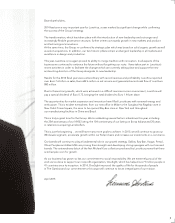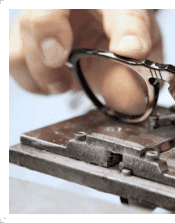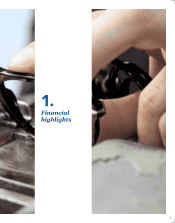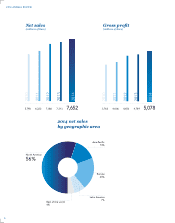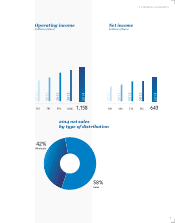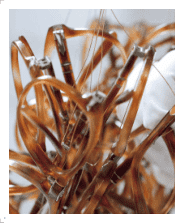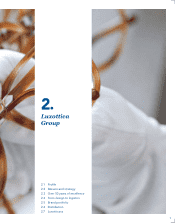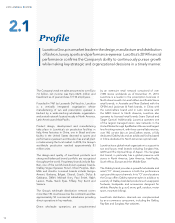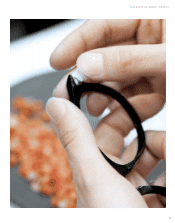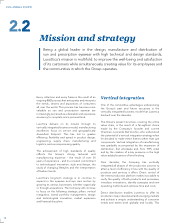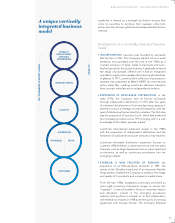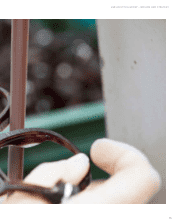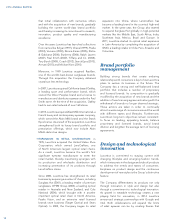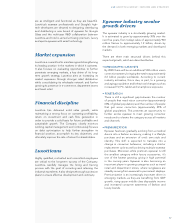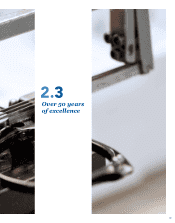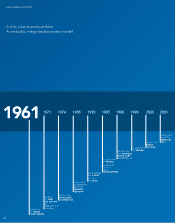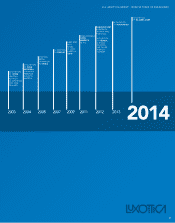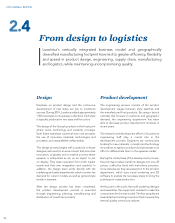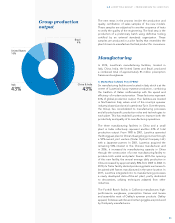LensCrafters 2014 Annual Report Download - page 15
Download and view the complete annual report
Please find page 15 of the 2014 LensCrafters annual report below. You can navigate through the pages in the report by either clicking on the pages listed below, or by using the keyword search tool below to find specific information within the annual report.
capability is viewed as a strength by fashion houses that
come to Luxottica to produce their eyewear collections
and access the Group’s global and widespread distribution
network.
Development of a vertically integrated business
model
Luxottica was founded by Leonardo
Del Vecchio in 1961. The Company started out as a small
workshop and operated until the end of the 1960s as a
contract producer of dyes, metal components and semi-
finished goods for the optical industry. It gradually widened
the range of processes offered until it had an integrated
manufacturing structure capable of producing a finished pair
of glasses. In 1971, Luxottica’s first collection of prescription
eyewear was presented at Milan’s MIDO (an international
optics trade fair), marking Luxottica’s definitive transition
from contract manufacturer to independent producer.
in the
early 1970s, the Company sold its frames exclusively
through independent distributors. In 1974, after five years
of sustained development of its manufacturing capacity, it
started to pursue a strategy of vertical integration, with the
goal of distributing frames directly to retailers. The first step
was the acquisition of Scarrone S.p.A., which had marketed
the Company’s products since 1971 bringing with it a vital
knowledge of the Italian eyewear market.
Luxottica’s international expansion began in the 1980s
with the acquisition of independent distributors and the
formation of subsidiaries and joint ventures in key markets.
Luxottica’s wholesale distribution expansion focuses on
customer differentiation, customized service and new sales
channels, such as large department stores, travel retail and
e-commerce, as well as continuous penetration into the
emerging markets.
the
acquisition of La Meccanoptica Leonardo in 1981, the
owner of the Sferoflex brand and of an important flexible
hinge patent, enabled the Company to enhance the image
and quality of its products and increase its market share.
From the late 1980s, eyeglasses, previously perceived as
mere sight-correcting instruments, began to evolve into
“eyewear”. Continual aesthetic focus on everyday objects
and designers’ interest in the emerging accessories
industry led Luxottica to embark on its first collaboration
with the fashion industry in 1988 by entering into a licensing
agreement with Giorgio Armani. The Company followed
2.2
A unique vertically
integrated business
model
13
GO-TO-MARKET & SUPPLY CHAIN
PRODUCT
DEVELOPMENT
(DESIGN &
ENGINEERING)
QUALITY
LOGISTICS
RETAILWHOLESALE
DISTRIBUTION
CUSTOMERS
MANUFACTURING


